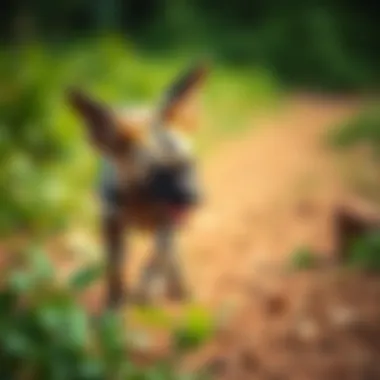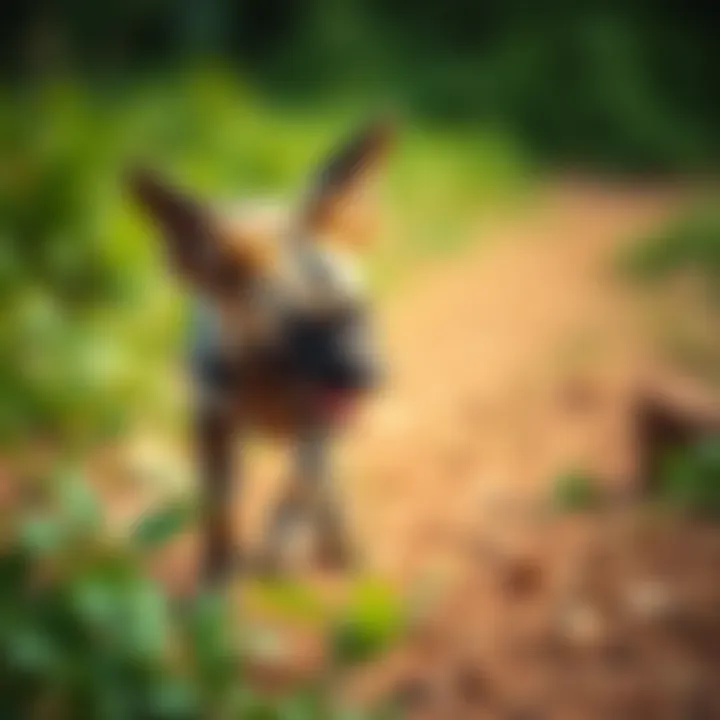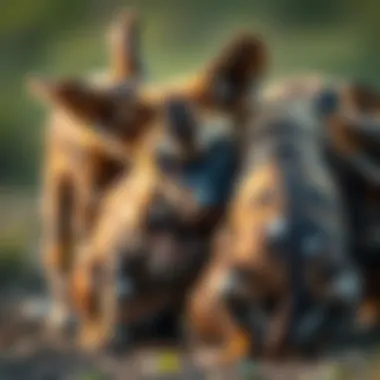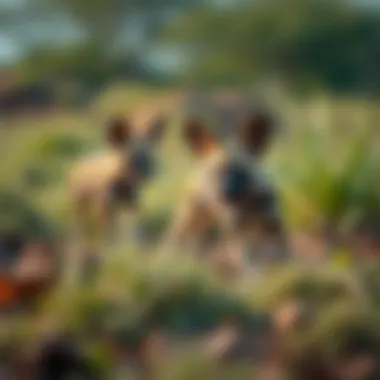Exploring the Life of African Wild Dog Puppies


Intro
Diving into the life of African wild dog puppies presents an enchanting yet challenging tale. Originating from the African savannah, these pups embody the essence of resilience and adaptability in the wild. Unlike typical domestic dogs, African wild dog puppies possess a distinctive way of learning and thriving within their pack dynamics. From the moment they take their first steps, they're immersed in a tightly-knit social structure that serves as both a playground and a survival school.
These puppies are not just adorable faces; they represent the future of their species. As one of the most endangered carnivores in Africa, understanding their early life stages is crucial for effective conservation efforts. The more we learn about their behaviors, development, and the environmental pressures they face, the better we can contribute to sustaining their populations. This exploration aims to illuminate the intricate details surrounding these fascinating animals, ensuring their survival in the wild for generations to come.
Prelude to African Wild Dogs
African wild dogs, scientifically known as Lycaon pictus, represent a highly social and specialized carnivore species found primarily in sub-Saharan Africa. These creatures are not just key predators; they also play a critical role in their ecosystem, maintaining the balance between prey species and vegetation. Understanding African wild dogs involves delving into their behavior, social structure, and the unique qualities that set them apart from other canids.
The significance of investigating African wild dogs cannot be overstated. It provides insights into the complexities of their pack dynamics, hunting strategies, and the developmental stages of their young. For wildlife biologists, this knowledge is essential for species conservation, especially considering their precarious status, where populations are rapidly declining. By deepening our understanding of these animals, we also foster greater appreciation among the general public, helping to cultivate a sense of responsibility for their preservation.
Defining African Wild Dogs
Defining African wild dogs goes beyond simply identifying them as members of the canid family. These animals are characterized by their distinctive coat patterns—typically a patchwork of yellow, black, brown, and white. Their physical adaptations, like long legs and large ears, not only add to their unique appearance but also enhance their hunting tactics through improved sight and hearing. Unlike domestic dogs, African wild dogs are known for their remarkable stamina, being able to sustain high speeds over long distances, which is crucial during their cooperative hunts.
Furthermore, African wild dogs exhibit distinct social structures, living in packs that can vary in size from two to 27 individuals. This social cohesion is vital for their survival, as they rely on teamwork for hunting and rearing their young. The bonds formed within these packs are essential in ensuring the safety and well-being of the puppies as they grow up in a challenging environment.
Taxonomy and Classification
When we talk about the taxonomy and classification of African wild dogs, we must recognize their unique standing within the animal kingdom. Classified under the Carnivora order, they are the sole members of the genus Lycaon, differentiating them from familiar domestic dogs and wolves. This separation is notable as African wild dogs, or painted wolves as they are sometimes called, possess unique behavioral traits and genetic distinctions that set them apart from other canids.
Their classification is rooted in their evolutionary history, revealing a significant divergence from other dog species roughly 6 million years ago. This divergence illustrates not just a difference in physical characteristics, but also adaptability to diverse habitats ranging from savannas to semi-deserts. While their population is currently classified as endangered by organizations such as the International Union for Conservation of Nature, understanding their taxonomy highlights the conservation challenges they face.
"Understanding the taxonomy of African wild dogs is crucial for establishing effective conservation strategies and enhancing our knowledge of their ecological role."
In summary, both defining and classifying African wild dogs reveals their complex nature as a species. The deeper we explore these facets, the better equipped we become to appreciate their ecological significance and the urgent need for their conservation.
Life Cycle of African Wild Dog Puppies
The life cycle of African wild dog puppies is a crucial element in understanding not just their behavior but also their survival strategies and ecological roles. From the moment of conception to their eventual independence, each phase contributes significantly to their development, which is integral to the survival of the species. Observing the intricacies of this life cycle illuminates how these unique canines fit into their environment, especially considering their endangered status due to habitat loss and other human-related challenges. A detailed exploration of their early life stages sheds light on their complexities and emphasizes the need for targeted conservation efforts.
Gestation Period and Birth
The gestation period for African wild dogs typically lasts about 70 days. During this timeframe, the female undergoes several physiological changes to prepare for motherhood. This period is crucial as it influences the health and viability of the newborn pups. Wild dog mothers often seek solitude in a den for the birthing process, creating a secure environment. The average litter ranges from 2 to 20 pups, but 10 is a common number.
This stage is essential as the survival of the puppies hinges on how well the mother can nurture them in those critical early days. Right after birth, the pups are born blind, weighing between 300 to 500 grams, and completely depend on their mother for sustenance. It’s fascinating to note, the dense fur assists in thermoregulation, a key feature considering the varying climate range in their habitats that can affect young and vulnerable puppies. If conditions are safe, the den serves as a nurturing cradle until the puppies mature enough to emerge into the full world.
Early Development Stages
Neonatal Phase
In the neonatal phase, which lasts from birth until about 2 weeks of age, the puppies rely heavily on their mother. During this time, their eyes begin to open, and they start to grow rapidly. This phase is characterized by their almost complete vulnerability; they are unable to thermoregulate, which means they require the warmth and care of their mother and the den environment. The importance of this stage extends beyond mere survival; it sets the foundation for their physiological growth and emotional health.
Having a nurturing and protective mother is vital during the neonatal phase. The bonding that occurs is significant as it lays the groundwork for the puppies' future social relationships within the pack. However, one must consider that being overly reliant on their mother during this time can be a double-edged sword. If something happens to the mother, the entire litter faces dire consequences.
Transition to Mobility
The transition to mobility occurs between 2 weeks and 3 months of age, marking a pivotal phase in the life of these puppies. Here, they begin to stand and walk, improving their physical coordination daily. This gradual mobility is crucial as it allows them to explore their surroundings, an experience rich in learning opportunities.
This phase is particularly beneficial for the puppies' physical development, as engaging with their environment helps them build muscle and gain confidence. As they become more mobile, they're exposed to various stimuli, leading to better cognitive and social skills. However, the downside is that increased mobility also comes with higher risks. As they venture out, they face potential threats from predators, requiring careful monitoring by the alpha pair and adult pack members.
Socialization and Learning
Interactions with Siblings
Interactions among siblings play a vital role in the overall socialization of African wild dog puppies. Sibling rivalry is not uncommon, yet these interactions are essential for building competitive and social skills that are integral when joining the pack later on. As puppies engage in play-fighting or chase games, they develop agility and learn important social cues, like submission and dominance.


These experiences collaboratively shape their personalities and future roles within the pack. The boundary of playtime versus real aggression is a thin one, fostering an environment where learning occurs through observation and experience. However, too much rough play could lead to stress or injury, posing limitations on their development if not monitored.
Exploring the Pack Environment
Exploring the pack environment brings a whole new realm of learning. Puppies often follow older pack members, imitating their behaviors while gradually learning social structure and individual roles. This curious phase allows puppies to understand group dynamics and develop their instincts within a safe, social setting, where each encounter can be enlightening.
Additionally, this exploration fosters a strong sense of belonging and familial bonds. Despite potential chaos during exploratory play, these engagements strengthen the pack as a unit, enhancing teamwork during hunts and in protecting territory. Yet, a downside exists: naive exploration could lead to dangerous encounters with unfamiliar animals or humans.
Parental Care and Pack Structure
Parental care and pack structure play a pivotal role in the survival and well-being of African wild dog puppies. These elements not only shape the puppies’ upbringing but also instill vital social behaviors that will follow them into adult life. In this context, the dynamics of how the pack operates highlight the importance of cooperation and social bonding among various members, particularly between the adult dogs and the puppies. By examining these aspects, we can gain a better understanding of how the foundation for future pack life is laid during the earliest stages of development.
Role of the Alpha Pair
The alpha pair in an African wild dog pack is often seen as the cornerstone of the pack hierarchy, establishing roles, responsibilities, and social order. Typically, this duo is responsible for breeding, which means they are also the first line of defense for their offspring. The alpha female, especially during the gestation and lactation stages, takes on a primary role in nurturing the puppies. Her attentive nature ensures that the puppies receive all necessary care and nutrition.
Moreover, both alphas work together to teach vital survival skills. The alpha male contributes by bringing food back to the nursing female and her young. This not only supports the mother’s health but also reinforces the bond within the family unit. What emerges from such a setup is a capable, well-adjusted group of puppies that learn the importance of social interaction early on.
Pack Dynamics in Rearing
The Role of Helpers
Within a pack, not all members are parents; some are helpers who assist in the rearing of puppies. These helpers are typically subordinates but contribute significantly to the nurturing process. Their roles can be diverse—some may look after the young while others may bring food or even play with the puppies to engage them socially. This collective involvement offers several advantages for the pack.
Key characteristics of these helpers include:
- Multi-tasking: Helpers take on various responsibilities which ensure the puppies are fed and socialized.
- Learning Environment: The presence of multiple caregivers provides a rich environment where puppies can learn different behaviors and social cues.
While the advantages of having helpers in raising puppies are abundant, there are challenges as well. For instance, increased competition for resources might arise, leading to stiff competition among adult pack members. Nevertheless, this cooperative strategy is vital for the growth and development of the puppies, equipping them with skills critical for their survival.
Collective Hunting and Feeding
Another essential aspect of pack dynamics in rearing is collective hunting and feeding. In an African wild dog pack, shared hunting efforts enhance the survival rate for both adults and their young. Working as a unit increases the chances of successfully taking down prey, which is crucial during the demanding phases of raising puppies.
Some highlights of this practice include:
- Increased Efficiency: With multiple dogs involved, hunts are more often successful, providing sustenance for both pups and adults alike.
- Solidarity: This collective effort not only reinforces bonds among pack members but also assures that the puppies are exposed to active hunting at a young age, facilitating early lessons in resource acquisition.
The unique feature of collective hunting is its effectiveness in securing food for a larger number of individuals than would be possible alone. However, it comes with its own set of challenges, such as the potential for injury during hunts or food shortages due to competition with other predators. Overall, the benefits of communal hunting heavily outweigh these inconveniences, making it a functional method to support the pack structure.
"Social structures among African wild dogs are a testament to how cooperation can lead to greater success in raising young in a challenging ecosystem."
By understanding how parental care and pack structure function together, we peel back layers of complexity in the lives of African wild dog puppies, providing insight into their developmental journey within a cooperative environment.
Behavioral Traits of African Wild Dog Puppies
Understanding the behavioral traits of African wild dog puppies is crucial when delving into their lives and survival strategies. These traits not only illuminate their development but also reflect how they interact within their social structure and their environment. Each behavior serves a purpose; it’s all interwoven in a delicate tapestry of survival, learning, and thriving in the wild.
Play and Social Play Behavior
Play is fundamental for African wild dog puppies. During their early days, these pups engage in vigorous, energetic play which serves multiple functions. First, it helps in building physical fitness and refining their motor skills, making them agile hunters later on. While these games might seem like mere frolicking, they're honing essential skills like chasing, pouncing, and escaping; all vital as they mature into adult wild dogs.
Moreover, play serves as a medium for establishing social bonds. Puppies who interact playfully develop stronger relationships with their siblings, which translate later into cohesive pack behavior. They learn to communicate and listen through play, understanding boundaries and the importance of cooperation. It’s not just about fun; play prepares them for the serious business of life in the wild.
Communication Methods
Vocalizations
Vocalizations in African wild dog puppies are more than just noise; they are a crucial communication tool. The puppies use various sounds, from soft whines to sharp barks. This range helps them express needs, alert others of danger, and coordinate during hunts. One significant aspect of vocalization is its ability to convey urgency. For instance, a sharp yelp might signal an immediate threat or a call for help.


The key characteristic of vocalizations is their variability; different tones can signify different emotions or needs. This diversity makes vocalizations a popular choice for understanding their communication. The unique feature of their vocalizations lies in their distance effectiveness; sounds can travel far in the open plains of Africa. This ensures that even those far apart within the pack can stay informed. However, it’s worth noting that excessive barking might attract unwanted attention from predators, a potential drawback in the wild.
Body Language
Body language in African wild dog puppies is another essential element of their communication. It conveys feelings, intentions, and social hierarchies without uttering a single sound. A wagging tail or an erect stance can indicate playfulness, while a lowered posture may signal submission or fear. Understanding body language is foundational for the puppies as they learn to navigate their pack dynamics.
The key characteristic that makes body language especially significant is its subtlety. Unlike vocalizations that can often be heard far and wide, body language requires close observation, making it a beneficial choice for their social interactions. A unique feature of body language is how it can express complex emotions in a single gesture. For instance, a pup who seems to invite play while simultaneously maintaining a defensive stance is sending intricate signals to its siblings. Yet, this form of communication does come with its challenges; misinterpretation can lead to conflicts or insecurity within the pack.
Exploratory Behavior
Exploratory behavior in African wild dog puppies is what sparks curiosity. Puppies are naturally inquisitive, often found sniffing around bushes, investigating new scents, and following the leads of older pack members. This exploratory trait not only helps them learn about their surroundings but also builds their confidence.
During these explorations, they practice critical life skills such as assessing threats, figuring out which paths to take, and recognizing potential food sources. Engaging with their environment empowers pups, giving them necessary tools for survival as they grow.
In summary, the behavioral traits of African wild dog puppies, from their play to their communication methods and exploratory habits, are essential for their development within the pack. Recognizing these traits gives us insight into their challenges and the mechanisms they utilize to thrive in the wild.
Challenges Faced by African Wild Dog Puppies
The challenges faced by African wild dog puppies are not just unfortunate obstacles; they are a fundamental lens through which we can understand the dynamics of their survival in the wild. Young wild dogs, or puppies, encounter a variety of difficulties from the moment they are born. These challenges largely stem from environmental factors and human interactions, shaping the very nature of their existence.
Understanding these challenges is crucial as it affects not only the puppies’ lives but also the broader conservation efforts aimed at preserving this species. The delicate balance in their ecosystem, their hunting patterns, and even pack dynamics are all influenced by these external threats.
Predation Risks
Predation risks are a constant threat to African wild dog puppies. In the wild, these young canines are not at the top of the food chain. Their size and vulnerability make them prime targets for larger carnivores such as lions, hyenas, and leopards. It's not uncommon for adult predators to take advantage of the puppies' naivety, especially during the critical early months when they are most susceptible.
From the perspective of the puppies themselves, aggressive territorial encounters can mean life or death. They rely heavily on their pack for protection, learning quickly the importance of staying close to adults when venturing outside the den. In many cases, packs will adopt vigilance strategies wherein multiple members watch for threats, showcasing their instinctive social behaviors. This not only improves survival rates but also strengthens social bonds within the pack.
Human-Related Threats
Human-related threats present another layer of complexity in the lives of these puppies. As their habitats are increasingly encroached upon, these magnificent creatures find themselves facing unique struggles that impact their survival rates.
Habitat Loss
Habitat loss is arguably the most pressing threat facing African wild dog puppies today. As human populations grow, the need for land for farming, urban development, and infrastructure has led to severe reductions in available wilderness areas. This is particularly significant as wild dogs need considerable territory for hunting and socializing.
Loss of habitat means that the packs must travel further to find food and safe places to den, putting more stress on both the adults and the young. This also heightens their exposure to potential dangers, including conflicts with humans and other wildlife. The key characteristic of habitat loss is that it often occurs gradually but leads to abrupt consequences in the long run. Understanding this aspect is vital for those working in wildlife conservation, as employing strategies to retain or restore habitats can significantly influence the survival of these puppies.
- Key Characteristics of Habitat Loss:
- Decreased hunting grounds
- Increased competition for resources
- Fragmentation of pack territories
The unique feature of habitat loss emphasizes the need for collaborative conservation efforts that bind together local communities, governments, and wildlife organizations in strategies that can rehabilitate these environments.
Road Collisions
Road collisions pose yet another threat that is easy to underestimate. As roads crisscross through their territories, the likelihood of young wild dogs being struck by vehicles increases. This is particularly tragic as it claims not only individual puppies but also disrupts the pack dynamics when key members are lost.
Road collisions highlight the critical need for awareness and safety measures in areas where wild dogs roam. Key characteristics include the difficulty of teaching puppies about these dangers. The wild instinct does not prepare them for human-made hazards, and unlike natural predators, vehicles do not provide any warning. The unique feature here is the need for targeted education programs for communities living near these habitats, aimed at reducing speed limits and improving wildlife crossings.
- Key Characteristics of Road Collisions:
- Human-induced fatalities
- Disruption of social structures
"With every challenge faced, the path to survival teaches vital lessons that shape the next generation of African wild dogs. Their future lies in our understanding and protection."
For further reading on the conservation status and threats facing the African wild dog, the following resources may be helpful:


Conservation Status and Efforts
The conservation of African wild dogs is not just a noble endeavor; it is crucial for maintaining biodiversity and ecological balance in their habitats. As one of the most endangered species in Africa, understanding their conservation status and the various efforts aimed at safeguarding their future is not only significant for wildlife enthusiasts but also imperative for our ecosystems.
Global Population Assessment
Assessing the global population of African wild dogs is a common concern. Currently, it is estimated that only about 6,000 individuals remain in the wild. This number fluctuates based on habitat loss due to human activity, disease outbreaks, and competition with other species such as lions and hyenas.
The African wild dog is often considered a barometer of a healthy ecosystem. Some areas, such as Botswana, have maintained relatively stable populations. However, in many regions, these dogs have faced relentless challenges. The following points are critical in understanding the dynamics of their population:
- Habitat fragmentation due to agriculture and urbanization
- Increased encounters and conflicts with livestock
- Infectious diseases like canine distemper affecting populations
"The survival of African wild dogs is intricately linked to their habitats; when we lose one, we lose the other."
Protective Legislation
Legislation plays a pivotal role in protecting the future of the African wild dog. Various countries have enacted laws aimed at preserving their habitats and ensuring sustainable cohabitation with local communities. Some examples include:
- Protected Areas: National parks and reserves, such as Kruger National Park, offer safe havens for these wild canines.
- Wildlife Protection Acts: Many African nations have specific laws that criminalize poaching and habitat destruction, which can directly impact the survival of wild dogs.
- International Treaties: Agreements like the Convention on the Conservation of Migratory Species (CMS) provide a framework for transboundary cooperation to protect migratory species, including wild dogs.
These laws are essential as they not only create safe environments for these animals but also foster a sense of responsibility among local populations.
Community Awareness and Engagement
Community involvement is perhaps one of the most effective ways to ensure the sustainability of wild dog populations. Educational campaigns aimed at local communities help foster positive attitudes towards these predators. Understanding their ecological role can lead to:
- Reduced Human-Wildlife Conflict: When communities understand the importance of African wild dogs, they are less likely to resort to retaliatory killings.
- Incentives for Conservation: Initiatives like ecotourism create alternative income sources for locals, demonstrating the potential economic benefits of protecting wildlife.
- Engagement in Monitoring Efforts: Empowering communities to participate in conservation and monitoring initiatives increases ownership and commitment to protecting African wild dogs.
The Importance of African Wild Dogs in Ecosystems
African wild dogs are not just fascinating creatures; they play a pivotal role in maintaining healthy ecosystems across the savannas and bushlands of Africa. Their presence and behavior directly impact the environment, species diversity, and even human communities. Understanding their ecological role gives us insight into the intricate balance of wildlife and the need for effective conservation measures.
Trophic Dynamics
The relationship between African wild dogs and their prey demonstrates classic trophic dynamics. They primarily hunt medium-sized ungulates such as impalas, gazelles, and wildebeests. This predation plays a crucial role in controlling the populations of these species, preventing overgrazing and ensuring that the vegetation can thrive. When wild dog populations decline, the increased numbers of prey can lead to vegetation depletion, which ultimately affects other species dependent on these plants.
Furthermore, these dogs are known for their unique hunting strategies. They hunt in packs, employing teamwork that showcases their intelligence and adaptability. Their technique of exhausting prey through relentless pursuit highlights their role as apex predators in their ecosystems. In a well-balanced environment, healthy African wild dog populations contribute to a diverse and stable food web.
"In areas where African wild dogs thrive, there's a nexus of balanced species dynamics, evidence of a working ecosystem. Without them, these systems can become fragile, causing ripple effects through the food chain."
Biodiversity Indicators
African wild dogs serve as excellent indicators of biodiversity. Their presence is often linked to the overall health of the ecosystems in which they live. They require large territories that are not only rich in prey but also have sufficient cover for hunting and denning. Thus, areas with vibrant wild dog populations often signify a robust and diverse array of species. When conservationists monitor these dogs, they can gauge the health of broader ecological communities.
Their vulnerability to habitat destruction and competition from human activities makes African wild dogs a bellwether for ecological stability. If the population of these dogs dwindles, it typically signals underlying issues within the ecosystem, including habitat fragmentation and declining prey populations.
In essence, protecting African wild dogs is about safeguarding a larger tapestry of biodiversity. By preserving their habitats and ensuring their survival, we also bolster the myriad species that coexist within these ecosystems.
The End
The relevance of understanding African wild dog puppies extends beyond mere academic curiosity; it sheds light on interconnections within ecosystems and conservation efforts. This article encapsulates several key insights regarding the developmental stages, social behaviors, and the ecological importance of these remarkable animals.
Recap of Key Insights
- Developmental Stages: From gestation to independence, each phase of a puppy's life is critical. The early days, where they are nurtured by their parents and pack, sets the foundation for their future survival.
- Social Structure: These puppies thrive in a complex social structure where cooperation is paramount. The alpha pair guides the pack, while other members play vital roles in raising the young. This communal approach is a significant factor in their survival.
- Behavioral Insights: Notably, their playful interactions and communication methods shape their social skills. Understanding these behaviors is essential for those working in wildlife conservation and education, as it informs how we protect and rehabilitate these animals.
- Conservation Challenges: The threats faced by African wild dogs, particularly from human activity, highlight the need for ongoing and robust conservation efforts.
Future Research Directions
While this article has synthesized vital information, there's still a wealth of untapped knowledge about African wild dog puppies waiting to be explored. Future research could focus on:
- Longitudinal Studies: Observing the growth of puppies over extended periods can provide insight into their developmental milestones and survival rates as they transition into adulthood.
- Genetic Studies: Understanding the genetic diversity within populations may reveal vital information regarding susceptibility to diseases and adaptability to changing environments.
- Behavioral Ecology: Investigating how environmental factors influence their social behaviors and pack dynamics could yield valuable insights for conservation strategies.
"The future of African wild dog populations hinges significantly on our understanding and preservation of their young, which form the backbone of their communities."
In summary, grasping the intricacies of African wild dog puppies is essential for fostering their populations and preserving their habitat. As the world faces increasing environmental challenges, this understanding becomes ever more crucial.







